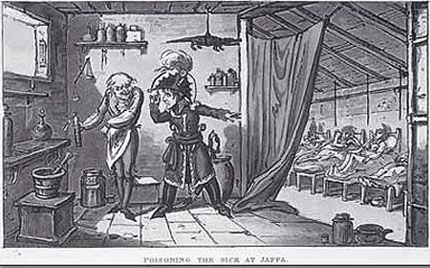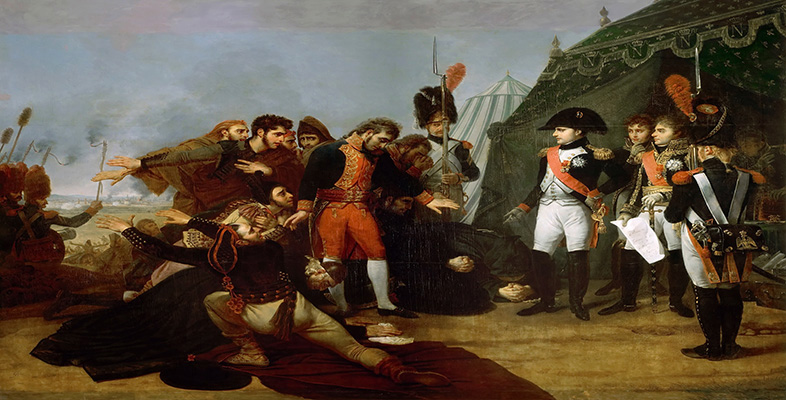3.2 The propaganda function of Jaffa
When Jaffa was exhibited in 1804, it was greeted with great acclaim and would thus seem to have fulfilled the propaganda purpose for which it was intended. Like The Battle of Nazareth, it deals with the later stages of the Egyptian campaign after the French had invaded Syria, which, like Egypt, formed part of the Ottoman (Turkish) empire. The French assault on Jaffa in March 1799 culminated in the massacre on Bonaparte's orders of some 2,500–3,000 Turks, who had surrendered the garrison in return for a promise that their lives would be spared. It also involved the rape and slaughter of many civilians. Such actions flatly contradicted the avowed purpose of the campaign, which was justified on the grounds that it was not so much a conquest as a liberation that would bring enlightenment to the benighted lands of the East. In order to back up this conception of a ‘civilizing mission’, Bonaparte brought large numbers of scholars, scientists and artists with him to Egypt. French soldiers not only carried out atrocities at Jaffa, however, but were also themselves struck down in large numbers by the plague there. On his retreat to Cairo, two months later, Bonaparte gave orders for those still alive to be poisoned so as to avoid having to evacuate them. It was this incident that was the most shocking from a contemporary European point of view, and the story rapidly gained currency in the British press (see Figure 5), some of the victims having survived to tell it to the British, who entered Jaffa after the French left. It also reached France, and it was clearly in order to counter these rumours that Gros was commissioned to paint his picture. Jaffa thus had a very specific propagandist function.
The painting depicts a visit made by Bonaparte in March 1799 to some of the plague-stricken French soldiers in a hospital in Jaffa. The catalogue of the 1804 Salon describes it as follows:
Bonaparte, general in chief of the army of the Orient, at the moment when he touched a pestilential tumour while visiting the hospital at Jaffa … To further distance the frightening idea of a sudden and incurable contagion, he had opened before him some pestilential tumours and touched several. He gave, by this magnanimous devotion, the first example of a genre of courage unknown until then and which has since had imitators.
(Quoted in Grigsby, 1995, p.9)
Bonaparte apparently did insist on the non-contagiousness of the disease, and according to his chief medical officer Desgenettes (who stands in the painting between Bonaparte and the sick man he is touching), he did have some physical contact with the plague-stricken during his visit. The precise subject seems to have been devised by Gros in consultation with Denon.

Click to see plate 3 Antoine-Jean Gros [Tip: hold Ctrl and click a link to open it in a new tab. (Hide tip)] , Bonaparte Visiting the Plague-Stricken of Jaffa, 1804, oil on canvas, 532.1 x 720cm, Louvre, Paris. Photo: Bridgeman Art Library
Exercise
Now look at the painting again (Plate 3) and consider the following questions:
- How does the image of Bonaparte that it offers serve to counter the accusations made against him? How might his action be seen (in the light of the catalogue entry) to embody enlightened ideals?
- How does Gros evoke the horrors of the plague? How might this contribute to the propagandist function of the painting?
- How does Gros evoke the Middle Eastern setting? How might this contribute to the propagandist function of the painting?
Discussion
- Completely ignoring the crimes that could be attributed to Bonaparte, both massacres and poisonings, the painting depicts him as calm and fearless in face of a terrible disease. His composure is heightened by contrast with the men on either side of him, one of whom covers his face with a handkerchief while the one kneeling on the right seems to want to protect him from infection. He is shown not as a ruthless tyrant capable of having his own men murdered, but rather as a compassionate leader willing to risk his own life for their well-being. He also embodies enlightened values since he touches one of the plague boils with the aim of dispelling a supposedly unfounded and thus irrational fear of contagion.
- The plague-stricken are mostly naked and slumped on the ground in poses expressive of mental and physical anguish (cowering in a corner, tearing their hair, desperately reaching out, etc.). They are also enveloped in shadow, as if to suggest that what they are going through is too horrific to be shown in the clear light of day; their blood-shot eyes stare out crazily through the darkness, and the blankets in which they are wrapped look rather like shrouds. The painting thus acknowledges that horrific suffering did take place and that French soldiers were among the victims, but attributes this suffering to a horrific natural cause, the plague, rather than French brutality or any other wrongdoing. This contributes to the propagandist function of the painting, as does the macabre fascination of the scene, which similarly distracts attention from the question of pinning down the blame.
- The architectural setting, with its pointed arches, elaborate crenellations and tall minaret, is indicative of a Middle Eastern setting, as too are the turbans and flowing robes of the Arab figures. The warm, golden light and extensive use of red also serve to evoke a sultry, intense atmosphere that might be regarded as typically eastern. The overall sense of a mysterious, exotic place adds to the fascination of the composition and thus, like the plague horrors, enhances its propaganda function by side-stepping more mundane issues of accountability. In so far as the plague itself might be seen as a specifically eastern phenomenon, it is further implied that no Frenchman can have played any part in causing this suffering. Since the tricolour can be seen flying from the top of the city, the painting also appeals to patriotic pride in French victories and thus endorses a colonialist agenda, while also conveniently skirting round the fact that the French did not hold Jaffa.
